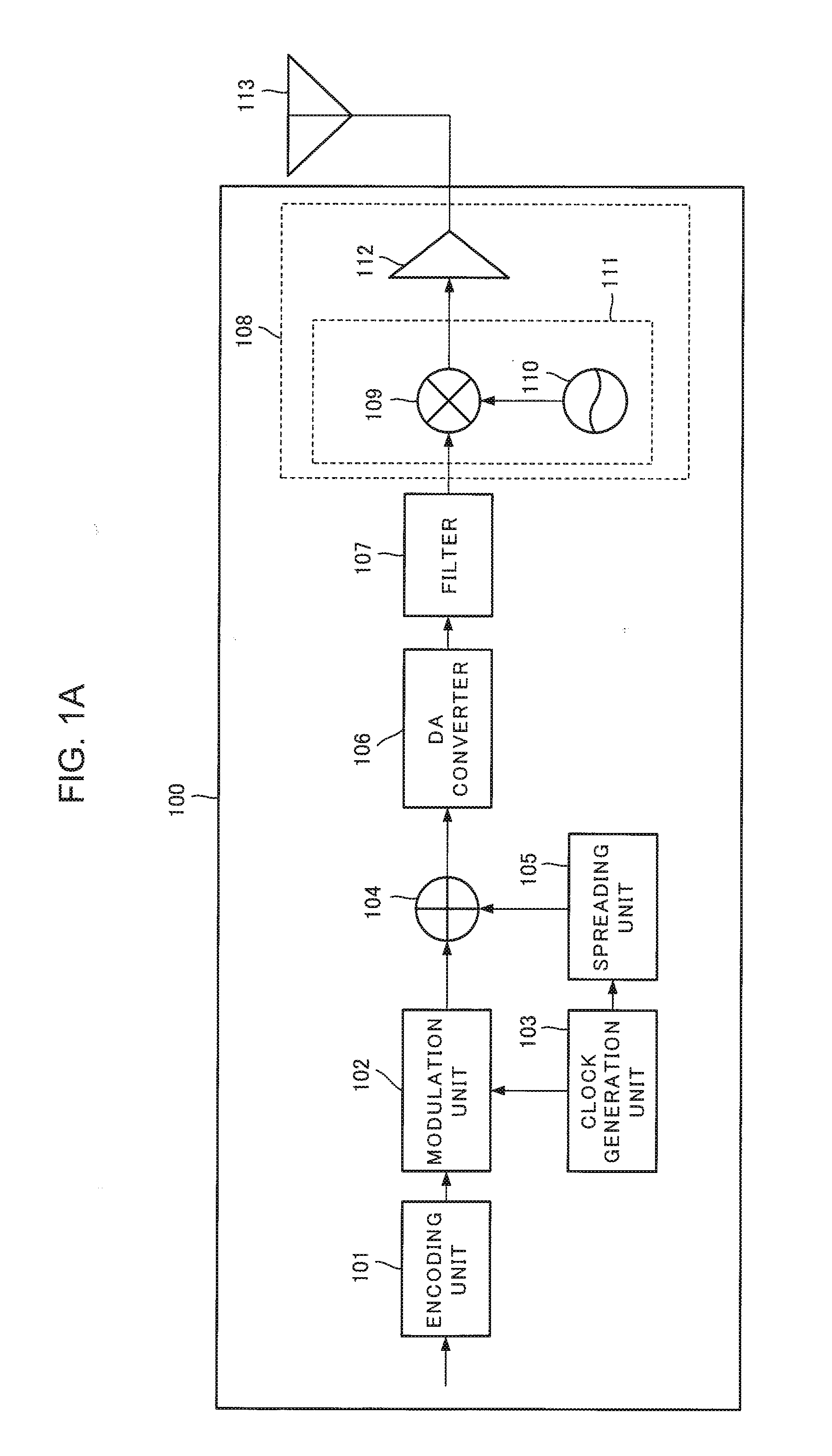Wireless transmission device, wireless reception device, wireless communication system, and wireless communication method
a wireless reception device and wireless communication technology, applied in the direction of transmission, electrical equipment, etc., can solve the problems of high fluctuation of transmission characteristics, high risk of fading, and high probability of low c/n operation, and achieve stable clock synchronization
- Summary
- Abstract
- Description
- Claims
- Application Information
AI Technical Summary
Benefits of technology
Problems solved by technology
Method used
Image
Examples
first exemplary embodiment
A first Exemplary Embodiment
[0039]A first exemplary embodiment of the present invention will be described. FIG. 10A illustrates a block diagram of a wireless transmission device, and FIG. 10B illustrates a block diagram of a wireless receiving device, in accordance with the present exemplary embodiment.
[0040]In FIG. 10A, a wireless transmission device 1 includes a clock generation unit 11, a spreading unit 12, an adder 13, and a transmission unit 14.
[0041]The clock generation unit 11 generates a clock signal (CLK). The spreading unit 12 multiplies the clock signal by a spreading code and generates a spread-spectrum clock signal (spread-spectrum CLK) whose spectrum is made to spread. The adder 13 superimposes an information signal to be transmitted on the spread-spectrum clock signal. The transmission unit 14 performs frequency conversion (up-conversion) on the output from the adder 13 and transmits an up-converted signal by wireless.
[0042]In FIG. 10B, a wireless receiving device 2 i...
second exemplary embodiment
A Second Exemplary Embodiment
[0048]A second exemplary embodiment will be described. First, a wireless transmission device will be described. FIG. 1A illustrates a block diagram of a wireless transmission device in accordance with the present exemplary embodiment. In FIG. 1A, a wireless transmission device 100 includes an encoding unit 101, a modulation unit 102, a clock generation unit 103, an adder 104, a spreading unit 105, a DA (digital to analog) converter 106, a filter 107, a transmission unit 108, and a transmitting antenna 113.
[0049]The encoding unit 101 encodes an inputted data signal using an error-correcting code, for example, and supplies the encoded signal to the modulation unit 102.
[0050]The clock generation unit 103 generates a clock signal and supplies the generated clock signal to the modulation unit 102 and the spreading unit 105. The clock generation unit 103 in accordance with the present exemplary embodiment includes a phase locked loop (PLL), for example, and ou...
third exemplary embodiment
A Third Exemplary Embodiment
[0083]A third exemplary embodiment will be described. FIG. 8 and FIG. 9 illustrate block configuration diagrams of a wireless transmission device 100C and a wireless receiving device 200B, respectively, which are applied to the non-line-of-sight communication by fourfold diversity using two antennas (space diversity) and two frequencies (frequency diversity).
[0084]The branch number L of the space diversity is not limited to two, and the branch number L of the frequency diversity is not limited to two. However, since L-fold bandwidth is required for the branch number L of the frequency diversity, the frequency efficiency is down, and L-fold transmission power is required.
[0085]In FIG. 8, only a single line is illustrated with respect to an adder 104, a DA converter 106, and a filter 107. In FIG. 9, although each of receiving units 202a to 202d performs wireless quadrature demodulation and outputs intermediate frequency (IF) signals having each of I and Q c...
PUM
 Login to View More
Login to View More Abstract
Description
Claims
Application Information
 Login to View More
Login to View More - R&D
- Intellectual Property
- Life Sciences
- Materials
- Tech Scout
- Unparalleled Data Quality
- Higher Quality Content
- 60% Fewer Hallucinations
Browse by: Latest US Patents, China's latest patents, Technical Efficacy Thesaurus, Application Domain, Technology Topic, Popular Technical Reports.
© 2025 PatSnap. All rights reserved.Legal|Privacy policy|Modern Slavery Act Transparency Statement|Sitemap|About US| Contact US: help@patsnap.com



